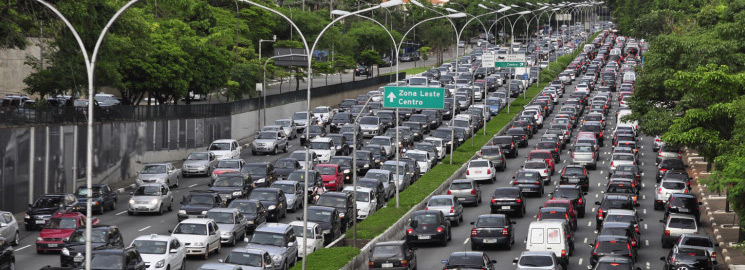Almost everyone has sat through a traffic jam. It’s awful in so many ways — the constant stopping, cars as far as the eye can see and worst of all, the lack of explanation for what caused it once you drive up to the front. Turns out there’s a term to describe these traffic bottlenecks that appear even when there’s no accident ahead: phantom traffic jams.
These unexplained backups happen when a car suddenly decides to brake, causing the car behind it to slow down. This causes a ripple effect down the lane and builds up until it creates a full-blown traffic jam.
Studies has shown that motorists spend almost six months of their lives stuck in some type of traffic jam – some can be attributed to accidents or road works, while others have no obvious explanation and are now being described as “phantom” bottlenecks which appear for no apparent reason and then disperse. It just takes one motorist to get to close to the car in front and hit the brakes. The driver behind does the same thing, as do many other motorists in succession. Within moments there is a ripple effect causing a long line of vehicles to slow down or stop which can stretch miles long.
It looks as if these ‘stop-and-go’ movements are generated by very small events at the level of individual vehicles where it can just be bad lane changing, which increases to such an extent that the impact is much bigger than the original event which caused it. In certain situations a tipping point is reached that magnifies small effects to create large changes that can involve hundreds of vehicles and which may be a couple of miles long.
Phantom traffic jams were first studied in the 1930s and since then more than 1,000 papers have been published to explain the phenomenon. However, little has been done to solve it.
Past solutions tried to limit the number of cars on the road at a given time by using traffic lights and speed limit signs. That said, keeping the density down does reduce the incidence of traffic jams, but the problem then becomes you’re not making full use of the road. Many computer science and engineers who have studied this phenomena believe they now have a solution. They believe that if every car on the road keeps an equal distance between the car immediately ahead and behind, it’ll reduce many traffic slow downs and cut driving time by almost half. But as we all know, not all drivers are equal in their driving abilities and so this solution is not a realistic one.
The real solution seems to lie in a simple update to the adaptive cruise control technology finding its way onto many of the new vehicles today. Adaptive cruise control works by using sensors at the front of the car to detect and then keep the vehicle a safe distance from the car ahead. Researchers in this area are now working with companies like Toyota and Honda to add extra sensors at the rear of the car so that your vehicle, while on cruise control, will keep an equal distance between the vehicle ahead and behind it.
Constantly checking your rearview mirror and trying to judge an equal distance between the vehicle in front and behind you is not a good idea since it distracts drivers too much and increases the chance of an accident. So, until this new kind of adaptive cruise control system becomes standard on all vehicles, what drivers can do now is avoid tailgating the vehicle ahead irregardless of how slow that driver is ahead of you since allowing for generous gap between your vehicle and others is the only real way to decrease many phantom traffic jams.


Leave a Reply